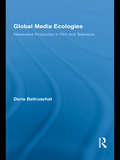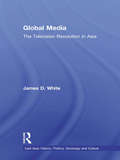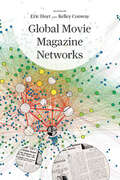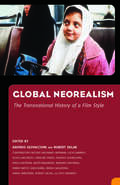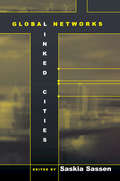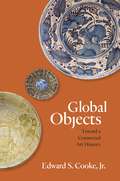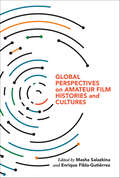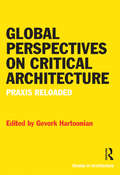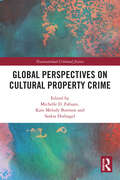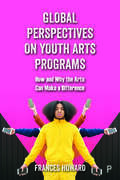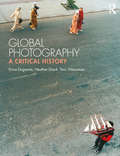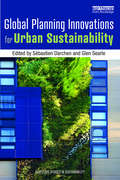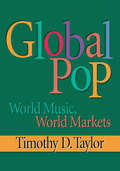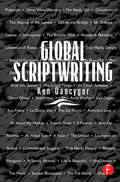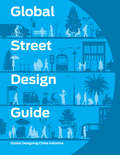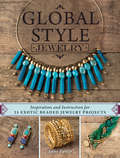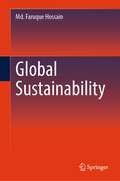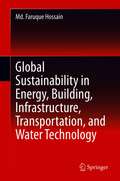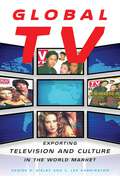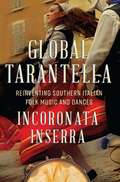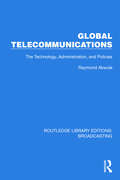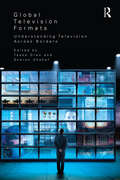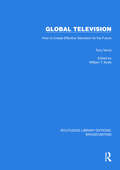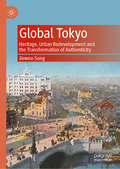- Table View
- List View
Global Media Ecologies: Networked Production in Film and Television (Routledge Advances In Internationalizing Media Studies #6)
by Doris BaltruschatIn this study, Baltruschat calls attention to dramatic changes in worldwide media production. Her work provides new insights into industry re-organization, digital media, and audience interactivity as pivotal relationships are redrawn along the entire value chain of production, distribution, and consumption. Based on an international study, she details how cultural agents now negotiate a media landscape through collaborative ventures, co-productions and format franchising. These varied collaborations define the new global media economy and affect a shift across the entire field of cultural production. Through detailing the intricacies of globally networked production ecologies, Baltruschat elucidates the shifting power relations in media production, especially in regards to creative labor and trade of intellectual properties. In the new global economy, "content" has become the "new currency." As a result, relational dynamics between cultural agents emerge as key forces in shaping worldwide cultural production, now increasingly characterized by flexible production and consumption. The blurring of lines in international media developments require new parameters, which define creativity and intellectual property in relation to interactive audiences and collaboratively produced content. Baltruschat clearly maps and defines these new dynamics and provides solutions as to how creative labor constellations can advance and enrich the new media economy. This is especially pertinent as global film and TV production does not necessarily result in greater media diversity. On the contrary, interdependencies in policy regimes, prioritization of certain genres, and branded entertainment epitomize how current networked ecologies reflect broader trends in cultural and economic globalization.
Global Media: The Television Revolution in Asia (East Asia: History, Politics, Sociology and Culture)
by James D. WhiteThis book is about the processes of globalization, demonstrated through a comparative study of three television case histories in Asia. Also illustrated are different approaches to providing television services in the world: public service (NHK in Japan), state (CCTV in China) and commercial (STAR TV, based in Hong Kong). Through its focus, Global Media addresses a considerable lacuna in the media studies literature, which tends to have a heavy Western bias. It provides an original addition to the literature on globalization, which is often abstract and anecdotal, in addition to making a major contribution to comparative research in Asia. Finally, it offers a thoughtful causal layered analysis, with a concluding argument in favor of public service television.
Global Movie Magazine Networks
by Eric Hoyt and Kelley ConwayA free ebook version of this title is available through Luminos, University of California Press’s Open Access publishing program. Visit www.luminosoa.org to learn more. This groundbreaking collection of essays from leading film historians features original research on movie magazines published in China, France, Germany, India, Iran, Latin America, South Korea, the U.S., and beyond. Vital resources for the study of film history and culture, movie magazines are frequently cited as sources, but rarely centered as objects of study. Global Movie Magazine Networks does precisely that, revealing the hybridity, heterogeneity, and connectivity of movie magazines and the important role they play in the intercontinental exchange of information and ideas about cinema. Uniquely, the contributors in this book have developed their critical analysis alongside the collaborative work of building digital resources, facilitating the digitization of more than a dozen of these historic magazines on an open-access basis.
Global Neorealism: The Transnational History of a Film Style
by Saverio GiovacchiniContributions by Nathaniel Brennan, Luca Caminati, Silvia Carlorosi, Caroline Eades, Saverio Giovacchini, Paula Halperin, Neepa Majumdar, Mariano Mestman, Hamid Naficy, Sada Niang, Masha Salazkina, Sarah Sarzynski, Robert Sklar, and Vito ZagarrioIntellectual, cultural, and film historians have long considered neorealism the founding block of post-World War II Italian cinema. Neorealism, the traditional story goes, was an Italian film style born in the second postwar period and aimed at recovering the reality of Italy after the sugarcoated moving images of fascism. Lasting from 1945 to the early 1950s, neorealism produced world-renowned masterpieces such as Roberto Rossellini's Roma, città aperta (Rome, Open City, 1945) and Vittorio De Sica's Ladri di biciclette (Bicycle Thieves, 1947). These films won some of the most prestigious film awards of the immediate postwar period and influenced world cinema. This collection brings together distinguished film scholars and cultural historians to complicate this nation-based approach to the history of neorealism. The traditional story notwithstanding, the meaning and the origins of the term are problematic. What does neorealism really mean, and how Italian is it? Italian filmmakers were wary of using the term and Rossellini preferred "realism." Many filmmakers confessed to having greatly borrowed from other cinemas, including French, Soviet, and American. Divided into three sections, Global Neorealism examines the history of this film style from the 1930s to the 1970s using a global and international perspective. The first section examines the origins of neorealism in the international debate about realist esthetics in the 1930s. The second section discusses how this debate about realism was “Italianized” and coalesced into Italian “neorealism” and explores how critics and film distributors participated in coining the term. Finally, the third section looks at neorealism’s success outside of Italy and examines how film cultures in Latin America, Africa, Asia, and the United States adjusted the style to their national and regional situations.
Global Networks, Linked Cities
by Saskia SassenIn her pioneering book The Global City, Saskia Sassen argued that certain cities in the postindustrial world have become central nodes in the new service economy, strategic sites for the acceleration of capital and information flows as well as spaces of increasing socio-economic polarization. One effect has been that such cities have gained in importance and power relative to nation-states. In this new collection of essays, Sassen and a distinguished group of contributors expand on the author's earlier work in a number of important ways, focusing on two key issues. First, they look at how information flows have bound global cities together in networks, creating a global city web whose constituent cities become global through the networks they participate in. Second, they investigate emerging global cities in the developing world-Sao Paulo, Shanghai, Hong Kong, Mexico City, Beirut, the Dubai-Iran corridor, and Buenos Aires. They show how these globalizing zones are not only replicating many features of the top tier of global cities, but are also generating new socio-economic patterns as well. These new patterns of development promise to lead to significant changes in the structure of the global economy, as more and more cities worldwide are integrated into globalization's circuitry. Includes contributions from:Linda Garcia, Patrice Riemens, Geert Lovink, Peter Taylor, David Smith, Michael Timberlake, Stephen Graham, Sueli Schiffer Ramos, Christoff Parnreiter, Felicity Gu, David Meyer, Pablo Ciccolella, Iliana Mignaqui, Eric Huybrechts, Ali Parsa. Also includes six maps.
Global Nollywood: The Transnational Dimensions of an African Video Film Industry (African Expressive Cultures)
by Matthias Krings and Onookome Okome“Reveals in fascinating detail the wild popularity, controversies, and complaints provoked by this film form . . . shap[ing] the media landscape of Africa.” —Brian Larkin, Barnard CollegeGlobal Nollywood considers this first truly African cinema beyond its Nigerian origins. In fifteen lively essays, this volume traces the engagement of the Nigerian video film industry with the African continent and the rest of the world. Topics such as Nollywood as a theoretical construct, the development of a new, critical film language, and Nollywood’s transformation outside of Nigeria reveal the broader implications of this film form as it travels and develops. Highlighting controversies surrounding commodification, globalization, and the development of the film industry on a wider scale, Global Nollywood gives sustained attention to Nollywood as a uniquely African cultural production.“Offers original material with respect to the transnational presence of Nollywood.” ?Moradewun Adejunmobi, University of California, Davis“Unveils a fascinating variety of the ways in which Nollywood cinema is viewed and interpreted.” ?Research in African Literatures“Delightfully entertaining yet appropriately erudite. . . . A welcome addition to the fields of film, media, African, and cultural studies.” —Cinema Journal“Highly recommended.” ?Choice“[T]he cumulative effect of [these] studies is to provide invaluable information for those wishing to keep up with where African cinema is today.” ?Journal of African History“Global Nollywood represents the most up-to-date research on Nollywood as a transnational cultural practice and is a must-read for scholars and students of African screen media.” —African Studies Review“Ground-breaking. . . . It proves that, in spite of appearing to be a niche market, Nollywood . . . can no longer be excluded from the canon of African cinema in the field of film studies.” ?African Affairs
Global Objects: Toward a Connected Art History
by Edward S. CookeA bold reorientation of art history that bridges the divide between fine art and material culture through an examination of objects and their usesArt history is often viewed through cultural or national lenses that define some works as fine art while relegating others to the category of craft. Global Objects points the way to an interconnected history of art, examining a broad array of functional aesthetic objects that transcend geographic and temporal boundaries and challenging preconceived ideas about what is and is not art.Avoiding traditional binaries such as East versus West and fine art versus decorative art, Edward Cooke looks at the production, consumption, and circulation of objects made from clay, fiber, wood, and nonferrous base metals. Carefully considering the materials and process of making, and connecting process to product and people, he demonstrates how objects act on those who look at, use, and acquire them. He reveals how objects retain aspects of their local fabrication while absorbing additional meanings in subtle and unexpected ways as they move through space and time. In emphasizing multiple centers of art production amid constantly changing contexts, Cooke moves beyond regional histories driven by geography, nation-state, time period, or medium.Beautifully illustrated, Global Objects traces the social lives of objects from creation to purchase, and from use to experienced meaning, charting exciting new directions in art history.
Global Perspectives on Amateur Film Histories and Cultures
by Masha Salazkina and Enrique Fibla-GutiérrezFor too long, the field of amateur cinema has focused on North America and Europe. In Global Perspectives on Amateur Film Histories and Cultures, however, editors Masha Salazkina and Enrique Fibla-Gutiérrez fill the literature gap by extending that focus and increasing inclusivity. Through carefully curated essays, Salazkina and Fibla-Gutiérrez bring wider meaning and significance to the discipline through their study of alternative cinema in new territories, fueled by different historical and political circumstances, innovative technologies, and ambitious practitioners. The essays in this volume work to realize the radical societal democratization that shows up in amateur cinema around the world. In particular, diverse contributors highlight the significance of amateur filmmaking, the exhibition of amateur films, the uses and availability of film technologies, and the inventive and creative approaches of filmmakers and advocates of amateur film. Together, these essays shed new light on alternative cinema in a wide range of cities and countries where amateur films thrive in the shadow of commercial and conventional film industries.
Global Perspectives on Critical Architecture: Praxis Reloaded
by Gevork HartoonianJudging from the debates taking place in both education and practice, it appears that architecture is deeply in crisis. New design and production techniques, together with the globalization of capital and even skilled-labour, have reduced architecture to a commodified object, its aesthetic qualities tapping into the current pervasive desire for the spectacular. These developments have changed the architect’s role in the design and production processes of architecture. Moreover, critical architectural theories, including those of Breton, Heidegger and Benjamin, which explored the concepts of technology, modernism, labour and capital and how technology informed the cultural, along with later theories from the 1960s, which focused more on the architect’s theorization of his/her own design strategies, seem increasingly irrelevant. In an age of digital reproduction and commodification, these theoretical approaches need to be reassessed. Bringing together essays and interviews from leading scholars such as Kenneth Frampton, Peggy Deamer, Bernard Tschumi, Donald Kunze and Marco Biraghi, this volume investigates and critically addresses various dimensions of the present crisis of architecture. It poses questions such as: Is architecture a conservative cultural product servicing a given producer/consumer system? Should architecture’s affiliative ties with capitalism be subjected to a measure of criticism that can be expanded to the entirety of the cultural realm? Is architecture’s infusion into the cultural the reason for the visibility of architecture today? What room does the city leave for architecture beyond the present delirium of spectacle? Should the thematic of various New Left criticisms of capitalism be taken as the premise of architectural criticism? Or alternatively, putting the notion of criticality aside is it enough to confine criticism to the production of insightful and pleasurable texts?
Global Perspectives on Cultural Property Crime (Transnational Criminal Justice)
by Michelle D. Fabiani, Kate Melody Burmon and Saskia HufnagelThis book provides transnational insight into cultural property crimes and the cutting-edge work tackling issues ranging from currency crimes to innovative research methods. The volume brings together authors from a number of fields to address contemporary issues and advances in the fight against cultural property crime. It combines the perspectives of law enforcement officials, researchers, journalists, lawyers, and scholars, with specialities in the disciplines of criminology, law, archaeology, museum studies, political science, and economics, from countries all around the globe. This allows for a more comprehensive examination of issues facing these professionals and highlights similarities between the challenges encountered in different disciplines as well as in diverse locations. It seeks to disseminate the most current work in this field from a broad array of viewpoints in order to further facilitate an exchange of ideas and lay the groundwork to inspire future collaborations. Most significantly, it provides more specific suggestions for moving forward that could help assist stakeholders to connect and work directly with each other, despite international borders and discipline-related boundaries. The book will be a valuable resource for researchers, practitioners, and policymakers working in the area of cultural property crime.
Global Perspectives on Youth Arts Programs: How and Why the Arts Can Make a Difference
by Frances HowardHow do young people develop through youth arts programs and how can these programs reflect and extend young people’s personal interests? How can youth arts support participatory democracy and social change? Frances Howard puts forward a powerful case for the value of youth arts programs, whilst acknowledging and interrogating the complexities involved, including unequal access to provision and the class-based harm that can be inadvertently practiced within them. Drawing on the author's own practice experience, alongside a range of international case studies showing best practice, this grounded and accessible text will be welcome reading to academics, students and practitioners across Education, Youth and Community courses.
Global Photography: A Critical History
by Terri Weissman Heather Diack Erina DuganneThis innovative text recounts the history of photography through a series of thematically structured chapters. Designed and written for students studying photography and its history, each chapter approaches its subject by introducing a range of international, contemporary photographers and then contextualizing their work in historical terms. The book offers students an accessible route to gain an understanding of the key genres, theories and debates that are fundamental to the study of this rich and complex medium. Individual chapters cover major topics, including: · Description and Abstraction · Truth and Fiction · The Body · Landscape · War · Politics of Representation · Form · Appropriation · Museums · The Archive · The Cinematic · Fashion Photography Boxed focus studies throughout the text offer short interviews, curatorial statements and reflections by photographers, critics and leading scholars that link photography's history with its practice. Short chapter summaries, research questions and further reading lists help to reinforce learning and promote discussion. Whether coming to the subject from an applied photography or art history background, students will benefit from this book's engaging, example-led approach to the subject, gaining a sophisticated understanding of international photography in historical terms.
Global Planning Innovations for Urban Sustainability (Routledge Studies in Sustainability)
by Sébastien Darchen Glen SearleAs the world becomes more urbanised, solutions are required to solve current challenges for three arenas of sustainability: social sustainability, environmental sustainability and urban economic sustainability. This edited volume interrogates innovative solutions for sustainability in cities around the world. The book draws on a group of 12 international case studies, including Vancouver and Calgary in Canada, San Francisco and Los Angeles in the US (North America), Yogyakarta in Indonesia, Seoul in Korea (South-East Asia), Medellin in Colombia (South America), Helsinki in Finland, Freiburg in Germany and Seville in Spain (Europe). Each case study provides key facts about the city, presents the particular urban sustainability challenge and the planning innovation process and examines what trade-offs were made between social, environmental and economic sustainability. Importantly, the book analyses to what extent these planning innovations can be translated from one context to another. This book will be essential reading to students, academics and practitioners of urban planning, urban sustainability, urban geography, architecture, urban design, environmental sciences, urban studies and politics.
Global Pop: World Music, World Markets
by Timothy D TaylorGlobal Pop examines the rise of "world musics" and "world beat", and some of the musicians associated with these recent genres such as Peter Gabriel, Ladysmith Black Mambazo, and Johnny Clegg. Drawing on a wide range of sources - academic, popular, cyber, interviews, and the music itself - Global Pop charts an accessible path through many of the issues and contradictions surrounding the contemporary movement of people and musics worldwide. Global Pop examines the range of discourses employed in and around world music, demonstrating how the central concept of authenticity is wielded by musicians, fans, and other listeners, and looks at some of these musics in detail, examining ways they are caught up in forms of domination and resistance. The book also explores how some cross-cultural collaborations may fashion new musics and identities through innovative combinations of sounds and styles.
Global Scriptwriting
by Ken DancygerGlobal Scriptwriting offers a look at an exciting new phase in screen storytelling, as writers and directors from all over the world infuse traditional forms with their own cultural values to create stories that have an international appeal and suggest a universality among readers, viewers, and listeners. A unique blend of screenwriting technique and film studies, Global Scriptwriting discusses screen stories as they have evolved through the years, focusing first on the basics of scriptwriting, then going on to afford a more sophisticated look at script via different models of scriptwriting: the Hollywood model, the independent model, the national model, and various alternative models. It examines the internationalization of storytelling, and illustrates how particular innovations have helped national screen stories to international success. This book is the first to incorporate the basics of the classical form with the innovative edge of the last decade, as well the culture specific changes that have taken place outside of North America. It offers readers a view of the enriched repertoire available to writers resulting from the introduction of cultural perspectives into traditional story forms. Specific topics examined include, the ascent of voice, the search for new forms, the struggle between style and content, and the centrality of megagenre.
Global Street Design Guide
by National Association of City Transportation Officials Global Designing Cities InitiativeEach year, 1.2 million people die from traffic fatalities, highlighting the need to design streets that offer safe and enticing travel choices for all people. Cities around the world are facing the same challenges as cities in the US, and many of these problems are rooted in outdated codes and standards.TheGlobal Street Design Guideis a timely resource that sets a global baseline for designing streets and public spaces and redefines the role of streets in a rapidly urbanizing world. The guide will broaden how to measure the success of urban streets to include: access, safety, mobility for all users, environmental quality, economic benefit, public health, and overall quality of life. The first-ever worldwide standards for designing city streets and prioritizing safety, pedestrians, transit, and sustainable mobility are presented in the guide. Participating experts from global cities have helped to develop the principles that organize the guide. TheGlobal Street Design Guidebuilds off the successful tools and tactics defined in NACTO'sUrban Street Design Guideand UrbanBikeway Design Guidewhile addressing a variety of street typologies and design elements found in various contexts around the world.This innovative guide will inspire leaders, inform practitioners, and empower communities to realize the potential in their public space networks. It will help cities unlock the potential of streets as safe, accessible, and economically sustainable places.Example cities include: Bangalore, India; Buenos Aires, Argentina; Paris, France; Copenhagen, Denmark; Seoul, Korea; Medellin, Colombia; Toronto, Canada; Istanbul, Turkey; Auckland, New Zealand; Melbourne, Australia; New York, USA; and San Francisco, USA.
Global Style Jewelry: Inspiration and Instruction for 25 Exotic Beaded Jewelry Projects
by Anne PotterInspiration and Instruction for 25 Exotic Beaded Jewelry Projects
Global Sustainability
by Md. Faruque HossainThis book focuses on holistic approaches to sustainability in all sectors of environment, energy, building, and infrastructure to achieve the best-balanced global environmental, energy, building, infrastructure, transportation, and water technologies (EBITWs). It presents a series of solutions based on innovative research and applications for building a sustainable Earth for future generations. Simply, the goal of this book is to define the context of instigation to think through the scientific theories and practical technical applications of sustainability for building a better planet. Naturally this book explains a series of mechanisms to develop a sustainable world by implementing mainly practicing the following areas of Sustainable Energy, Sustainable Housing and Building Technology, Sustainable Water, Infrastructure, and Transportation Technology, Sustainable Environment which are, very much interconnected to secure a global environmental equilibrium.
Global Sustainability in Energy, Building, Infrastructure, Transportation, and Water Technology
by Md. Faruque HossainThis book focuses on holistic approaches to sustainability in all sectors of building, infrastructure, and energy to achieve a best-balanced global energy, building, infrastructure, transportation, and water technology (EBITW) system using a series of innovative research and implementation solutions. The goal of this book is to define the context for proactive consideration of scientific theories and practical technical applications of sustainable development, following main seven themes: Renewable Energy Technology, Advanced Building Design Technology, Innovative Infrastructure and Transportation Engineering, Clean Water and Sanitation, Sustainable Urban and Rural Development, Clean Environment, and Sustainable Planet; which are very much interconnected to secure the global equilibrium. The book is prepared for a wide audience including researchers, field engineers, and students.
Global TV: Exporting Television and Culture in the World Market
by C. Lee Harrington Denise D. BielbyA reporter for the Los Angeles Times once noted that “I Love Lucy is said to be on the air somewhere in the world 24 hours a day.” That Lucy’s madcap antics can be watched anywhere at any time is thanks to television syndication, a booming global marketplace that imports and exports TV shows. Programs from different countries are packaged, bought, and sold all over the world, under the watch of an industry that is extraordinarily lucrative for major studios and production companies.In Global TV, Denise D. Bielb and C. Lee Harrington seek to understand the machinery of this marketplace, its origins and history, its inner workings, and its product management. In so doing, they are led to explore the cultural significance of this global trade, and to ask how it is so remarkably successful despite the inherent cultural differences between shows and local audiences. How do culture-specific genres like American soap operas and Latin telenovelas so easily cross borders and adapt to new cultural surroundings? Why is The Nanny, whose gum-chewing star is from Queens, New York, a smash in Italy? Importantly, Bielby and Harrington also ask which kinds of shows fail. What is lost in translation? Considering such factors as censorship and other such state-specific policies, what are the inevitable constraints of crossing over?Highly experienced in the field, Bielby and Harrington provide a unique and richly textured look at global television through a cultural lens, one that has an undeniable and complex effect on what shows succeed and which do not on an international scale.
Global Tarantella: Reinventing Southern Italian Folk Music and Dances
by Incoronata InserraTarantella, a genre of Southern Italian folk music and dance, is an international phenomenon--seen and heard in popular festivals, performed across the Italian diaspora, even adapted for New Age spiritual practices. The boom in popularity has diversified tarantella in practice while setting it within a host of new, unexpected contexts. Incoronata Inserra ventures into the history, global circulation, and recontextualization of this fascinating genre. Examining tarantella's changing image and role among Italians and Italian Americans, Inserra illuminates how factors like tourism, translation, and world music venues have shifted the ethics of place embedded in the tarantella cultural tradition. Once rural, religious, and rooted, tarantella now thrives in settings urban, secular, migrant, and ethnic. Inserra reveals how the genre's changing dynamics contribute to reimagining Southern Italian identity. At the same time, they translate tarantella into a different kind of performance that serves new social and cultural groups and purposes. Indeed, as Inserra shows, tarantella's global growth promotes a reassessment of gender relations in the Italian South and helps create space for Italian and Italian-American women to reclaim gendered aspects of the genre.
Global Telecommunications: The Technology, Administration and Policies (Routledge Library Editions: Broadcasting #22)
by Raymond AkwuleGlobal Telecommunications (1992) clarifies the complex, politically-charged arena of international telecommunications. By understanding both the demands created by dynamic Western countries in the grips of deregulation and the needs of developing nations, readers acquire an appreciation for the challenges facing global telecommunications users, developers and policymakers. This book stresses the growing need for sophisticated management of satellite and communication resources. The emerging global information society is propelled by technological innovations, and these developments are shaping the way the world’s population receives information.
Global Television Formats: Understanding Television Across Borders
by Tasha Oren Sharon ShahafWinner of the 2013 SCMS Best Edited Collection Award For decades, television scholars have viewed global television through the lens of cultural imperialism, focusing primarily on programs produced by US and UK markets and exported to foreign markets. Global Television Formats revolutionizes television studies by de-provincializing its approach to media globalization. It re-examines dominant approaches and their legacies of global/local and center/periphery, and offers new directions for understanding television’s contemporary incarnations. The chapters in this collection take up the format phenomena from around the globe, including the Middle East, Western and Eastern Europe, South and West Africa, South and East Asia, Australia and New Zealand, North America, South America, and the Caribbean. Contributors address both little known examples and massive global hits ranging from the Idol franchise around the world, to telenovelas, dance competitions, sports programming, reality TV, quiz shows, sitcoms and more. Looking to global television formats as vital for various cultural meanings, relationships, and structures, this collection shows how formats can further our understanding of television and the culture of globalization at large.
Global Television: How to Create Effective Television for the Future (Routledge Library Editions: Broadcasting #23)
by Tony VernaGlobal Television (1993) looks at how satellites, fibre optics, compressed digital transmission, and interactive and high-definition television have converged with computer technology to revolutionise TV and film production, TV sets and even the smart home in which TV is viewed. Its provides valuable insight into how new technologies and viewer demands have combined to transform television into a truly global medium.
Global Tokyo: Heritage, Urban Redevelopment and the Transformation of Authenticity
by Jiewon SongThis book examines heritage-led regeneration and decision-making processes in Tokyo’s urban centres of Nihonbashi and Marunouchi. Detailing some of the city’s most prominent and recent redevelopment projects, Jiewon Song recognizes key institutions and actors; their collective actions as placemakers; and how they project the authenticity of urban places in planning processes. Song argues that heritage-led regeneration tends to monopolize authenticity by weakening the visibility of other cultural and historic qualities in urban places. Authenticity consequently turns into a singular entity leading to the homogenization of urban places. As cities increasingly seek authenticity in the urban age, nation-states initiate top-down processes to achieve such ends, interweaving nationalism and national narratives into placemaking practices. In this fashion, Song challenges existing scholarship on urban conservation, global cities and the notion of authenticity.
